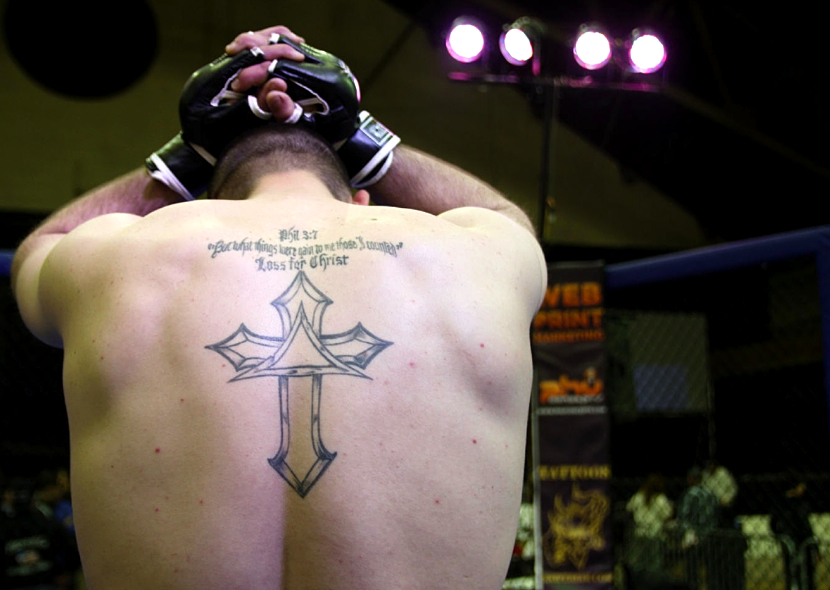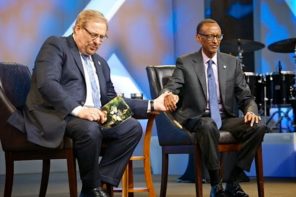Fight Church is a beautifully-made documentary about why Christian men, including pastors, participate in Mixed Martial Arts (MMA) cage fighting.
The film’s narrative is framed by a debate concerning whether or not Christians should support MMA, whether as fighters, trainers, and spectators. But these questions cannot be considered apart from the aesthetics of the film: the slow motion trajectory of fists, kicks, and body slams, choreographed to the romantic ambient score that serves as a soundtrack for the action in the cage.
The film’s style evokes an undercurrent that involves and exceeds directors Daniel Junge and Bryan Storkels’ goal “to tell this entertaining story in a completely objective tone.” Placing their film in context, they suggest that “Like the Oscar-nominated Jesus Camp, the film will present these incredibly provocative characters in an objective and often sympathetic light. We will ask the audience to come to their own conclusions about the connections between religion and condoned violence, as well as explore the growing mainstreaming of MMA in the US, and discuss Christianity in our post-modern society.”
But while documentary filmmakers insist that they are representing ‘authentic’ reality all the decisions they make during production and in the editing room, whether lighting, soundtrack, camera angles, interview questions…(the list goes on) cannot claim to be made ‘objectively.’ Against the claims of filmmakers like Junge and Storkels to objectivity we audience members need to fine-tune our critical perspective—as participants in visual culture, we need to understand our own culpability the brutality we see in Fight Church, whatever our opinion of the morality of MMA.
To our collective detriment, it has become the default of arenas where ideological conflict and entertainment blur, including news programming, to stage objectivity as simply the presentation of opposing viewpoints. In Fight Church, interviewees justify their positions for and against MMA using biblical verse, figures, and concepts—one of the most predominant articulated by both camps as being “love.” At the same time, the directors’ presumably good intentions are indexed by the time-lapse close ups of violence in the cage.
The pastors who promote MMA describe it as a “sport” through which to recapture man’s “God given attributes” of “aggressiveness” and “competitiveness”; the “strength to stand up to evil, wickedness, and unrighteousness”; a “warrior ethos”; and, the ability to “be prepared in advance” for a “battle out there” against an “enemy” that is “trying to seek and destroy us.”
While listening to such language, I could not help but think of Mars Hill, the church that remains embroiled in the recent controversy surrounding pastor Mark Driscoll.
Recent media coverage of Mars Hill’s ‘culture’ has focused on the graphically sexist, homophobic rhetoric Driscoll spewed relentlessly, using the anonymity afforded by an online alias, William Wallace II: a portrait in virtual violence.
Whether it is Driscoll or the men who justify the violence of MMA, the ‘matter’ of violence gets lost in (dis)embodied spectacles, both visual and virtual, that infect cultural imaginaries and affective atmospheres. In their brutality within the cage and online, Fight Church and Driscoll enact what it means to be ‘authentic’ men—pre-emptively on the attack and cynical in their assessment of opponents as they wage violence against them.
At one point in Fight Church, a former MMA fighter-pastor (who we later see puking while training to get back into shape in order to physically defend his wife’s honor after she was slandered by another man on Facebook), proclaims: “I don’t think [MMA] is violent at all and I hate the use of that word the way most people use it—[violent] actually means to violate another’s rights…someone gets raped or robbed, that’s violence. This is two participants entering into a ring or a cage, saying we’re going to test each other today and best man’s gonna win—that’s not violence.”
Making violence a legal issue concerning the right to (certain forms) of bodily autonomy makes sense given the way the fight sequences romanticize the “controlled strength” described by Fight Church pastor Paul Burress and others as a test, mano a mano. The film sentimentalizes individualized competition as the greatest of risks, reinforcing meritocracy as a moral metric in a ‘free market’ system. In this sense, it is no surprise that MMA is rising in popularity—its violence not only symbolizes ‘authentic’ sport, masculinity, and bodily autonomy but viscerally recruits and emotionally seduces regardless of whether we find it right or wrong.
The felt distinctions between repulsion and joy or horror and titillation are far blurrier and more difficult to dismiss in terms of their affective political value than claims to objectivity would lead us to believe.
Preston Hocker (aka “The Pastor of Disaster”) states from the pulpit, with a right eye purple and puffy the day after losing a fight, “in life you have to be willing to take risks, otherwise you might as well just stay home. Sometimes you take a risk, you get hit in the face.” After a boy who loses a fight begins sobbing Paul Burress tells him, “Don’t cry…this is a good experience,” as the camera provides a close up of the boy’s face, red with shame.
Scene after scene in which the frenzy of brute force is slowed for the viewer so that we can witness and linger upon the bending of bodies and wills at leisure, offers up this brutality as safely confined to the cage and stylized to a romantic score. It is an almost pornographic perspective, whereby the violence of MMA is reduced to bloodied faces against a blue mat, screeching ambulance sirens, and tough guys who describe their motive to train in terms of defending their wives and bringing people to Jesus at any cost.
Unfortunately, any physical or emotional weaknesses that index vulnerability or risk outside of entering a cage with body coiled ready to strike is not balanced by the cinematographic artistry used during the fight sequences.
I suggest that, good intentions aside, the aim of providing an objective view of any ‘culture war’ debate, no matter who is participating or what the issue under discussion, cannot help but perpetuate our fascination with, attachment to, and fetishization of, what it means to be ‘authentic’—to scripture, to being a ‘real man,’ or to other beliefs. Our capacity to be persuaded that simply offering ‘both sides’ is sufficient to cultivate understanding inhibits the curiosity we need to have in order to take risks to learn more. Risks like questioning our own beliefs as well as others’ with generosity rather than defensiveness.
As a pedagogical tool, Fight Church raises a poignant question that is among those I consider when I think on the question of what is to blame for the spiritually abusive culture of Mars Hill Church: What is lost when so much value is placed on the artistry of ‘authenticity’ in ‘image’?
Respectful dialogue requires a depth of vulnerability that entails risk, as well as a strength that supersedes the embodied spectacle of black eyes, bloodied faces, and sweaty muscles objectified by the camera’s lens and viewer’s gaze via Fight Church.
In the film (and according to Driscoll) “mainstream Christianity” is to blame for producing “feminized men.” The lack of women’s voices throughout the film leaves an easy opening for critique (much like the doctrine of male headship does Mars Hill). However, rather than linger on the lack of female representation onscreen, I would like to draw attention to what we do learn from one of the few women who appears that isn’t a pastor’s wife or parading around the fight cage, scantily clad, holding up numbers.
Although we never learn her full name or hear her speak, a woman fighter plays a key role in the film’s conclusion. As a victorious Burress preaches on Easter Sunday, he looks down at a woman he calls Linda who bears the searing, swollen black eye of defeat and says,
When Jesus was being tortured and beaten, and he fell down to his knees, he powered back up, and he took it, and the soldiers beat him senseless, and the blood streamed across his face, and he was bruised, he was probably barely recognizable, but he stayed there, he took it, and as he hung on that cross his last words were telling. Forgive them, cause they don’t know what they’re doin’, he said, Father forgive them cause they don’t know what they’re doin’.
As the soundtrack’s angelic choir crescendoes, the camera takes us behind Burress—from this perspective we look up at his muscled posture as he cradles a bible, staring into the stage lights.
In a recent article, director Bryan Storkel admits, “As I’ve attended film festival screenings of Fight Church over the past few months, I’ve been somewhat concerned with how quickly people will often jump on the bandwagon of the fighting pastors and agree with their justifications and methodologies. At times, I’ve wondered if we are helping feed something that I don’t completely agree with…”
If you’re wondering what ‘culture’ led to the rise in celebrity of Mark Driscoll, pay attention to how you feel as you watch Fight Church—the quickening of pulse, tingling of skin, clenching of jaw. Fight Church drives home the message, viscerally, that violence can be justified in the name of religion.





